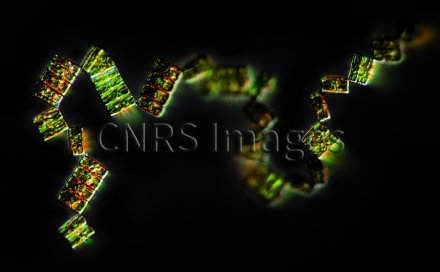Production year
2010

© Noé SARDET/Christian SARDET/Tara Océans/CNRS Images
20170108_0001
String of cells of the diatom thalassionema nitzschoides, observed using differential interference microscopy (DIC). Diatoms are protists (unicellular organisms having a nucleus), and a source of scientific interest for multiple reasons. They also contain chloroplasts rich in green pigments such as chlorophyll, and make up a large proportion of the biomass in the marine food chain. The chloroplasts enable them to capture and convert solar energy, generating oxygen and absorbing carbon dioxide gas in the process. By this means, diatoms produce one quarter of the Earth's oxygen. They may either live in isolation or else form - as seen here - long filaments, fans, zig-zags or spirals. These diatoms were collected at the Villefranche-sur-Mer Oceanology Observatory.
The use of media visible on the CNRS Images Platform can be granted on request. Any reproduction or representation is forbidden without prior authorization from CNRS Images (except for resources under Creative Commons license).
No modification of an image may be made without the prior consent of CNRS Images.
No use of an image for advertising purposes or distribution to a third party may be made without the prior agreement of CNRS Images.
For more information, please consult our general conditions
2010
Our work is guided by the way scientists question the world around them and we translate their research into images to help people to understand the world better and to awaken their curiosity and wonderment.